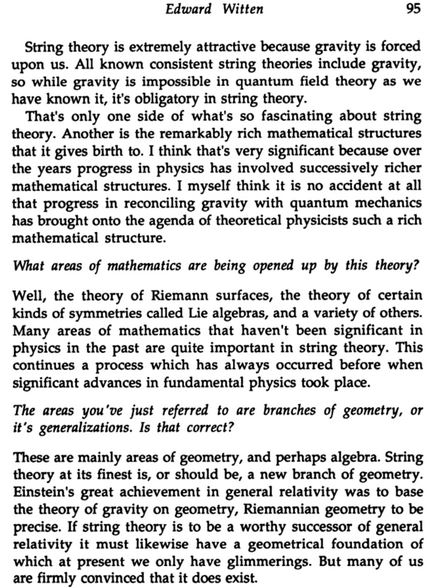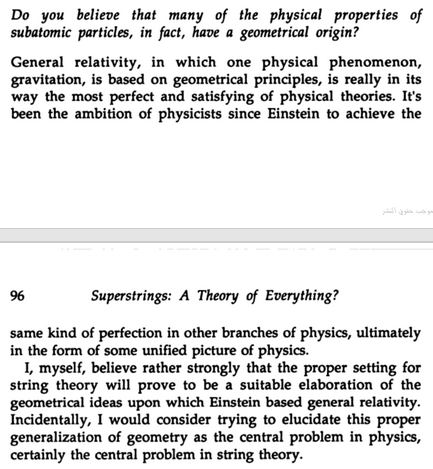nLab Edward Witten
Edward Witten is a theoretical physicist at the Institute for Advanced Study.
-
interview by Hirosi Ooguri, Notices Amer. Math. Soc, May 2015 p491 (pdf)
-
Adventures in Physics and Math, Kyoto Prize lecture 2014 (pdf, pdf)
Witten’s work originates in theoretical quantum field theory and stands out as making numerous and deep connections between that and mathematical geometry and cohomology. In the course of the 1980s Witten became the central and leading figure in string theory.
Insight gained from the study of quantum field theories and specifically those relevant in string theory led Witten to mathematical results deep enough to gain him a Fields medal, see below. Indeed, a whole list of sub-fields in mathematics originate in aspects of Witten’s work in QFT/string theory and carry his name, such as Chern-Simons theory which many people call “Chern-Simons-Witten theory”, Wess-Zumino-Witten theory, the Witten genus, Gromov-Witten theory, Seiberg-Witten theory, Rozansky-Witten invariant, the Witten conjecture. Other parts are still waiting to be absorbed into the mathematical literature such as Horava-Witten theory, Diaconescu-Moore-Witten anomaly etc..
Despite the deeply theoretical and abstract mathematical aspects of his work, Witten has visibly always been motivated by fundamental questions in the phenomenology of the standard model of particle physics and cosmology. (Indeed, some of his work on scattering amplitudes crucially enters into the experimental detection of the Higgs particle, for more on this see at string theory results applied elsewhere. ) He prominently argued that specifically heterotic string theory is a plausible candidate for a fundamental grand unified gauge field theory including quantum gravity.
Since about the turn of the millennium Witten has tended to more esoteric mathematical aspects of string theory, such as its relation to Khovanov homology and geometric Langlands duality which apparently the string theory community at large is following less enthusiastically than it was the case during the excited 1990s.
Contents
Quotes
On the (lack of) understanding of string theory and M-theory:
In Witten 87, very last sentence:
A properly developed theory of elliptic cohomology is likely to shed some light on what string theory really means.

In an interview recorded (1988) in:
- P C W Davis & J Brown (eds.), Superstrings: A theory of everything?, Cambridge University Press 1988, 1991, Canto 1992 (gbooks):
String theory at its finest is, or should be, a new branch of geometry. (p. 95)
I would consider trying to elucidate this proper generalization of geometry as the central problem of physics, certainly the central problem of string theory. (p. 96)
What should have happened, by rights, is that the correct mathematical structures should have been developed in the twenty-first or twenty-second century, and then finally physicists should have invented string theory as a physical theory that is made possible by these structures. (p. 102)
we are paying the price for the fact that we didn’t come by this thing in the usual way. (p. 103)

Further in Davis & Brown 1988, p. 102:
It’s been said that string theory is part of the physics of the twenty-first century that fell by chance into the twentieth century. That’s a remark that was made by a leading physicist [Daniele Amati, see below] about fifteen years ago. What he meant was that human beings on planet Earth never had the conceptual framework that would lead them to invent string theory on purpose. String theory was invented essentially by accident in a long sequence of events, starting with the Veneziano model that was formulated in 1968. No-one invented it on purpose, it was invented by a lucky accident. By rights, twentieth century physicists shoulnd’t have had the priviledge of studying this theory. By rights, string theory shouldn’t have been invented unitl our knowledge of some of the areas that are prerequisite for string theory had developed to the point that it was possible for us to have the right concept of what it was all about.
This point appears again in
- Edward Witten, Can scientists’ “theory of everything” really explain all the weirdness the universe displays?, American Scientist Astronomy Issue 2002 (pdf, pdf)
and also in Nova interview 2003:
Back in the early ’70s, the Italian physicist, Daniele Amati reportedly said that string theory was part of 21st-century physics that fell by chance into the 20th century. I think it was a very wise remark.
In an interview with Graham Farmelo, “The Universe Speaks in Numbers”, interview 5, 2019 (quote from 21:15 - 21:46):
I actually believe that string/M-theory is on the right track toward a deeper explanation. But at a very fundamental level it’s not well understood. And I’m not even confident that we have a good concept of what sort of thing is missing or where to find it. The reason I am not is that in hindsight it is clear the view given in the 1980s of what is missing was too narrow. Instead of discovering what we thought was missing, we broadened the picture in the 90s, in unexpected directions.
Fields medal work
In
- Michael Atiyah, On the work of Edward Witten, Proceedings of the International Congress of Mathematics, Kyoto 1990 (pdf, archive)
the following “influential papers” are listed as relevant for Edward Witten receiving the Fields Medal in 1990.
First of all
-
Supersymmetry and Morse theory, J. Differential Geom. Volume 17, Number 4 (1982), 661-692. (Euclid)
This discusses deformations of supersymmetric quantum mechanics on a Riemannian manifold and how its supersymmetric ground states are related to the Morse theory of a deformation function. The way this supersymmetric quantum mechanics appears as the point-particle limit of the type II superstring is explained at the end of
-
Global anomalies in string theory, in W. Bardeen and A. White (eds.) Symposium on Anomalies, Geometry, Topology, pp. 61–99. World Scientific, 1985
which otherwise is on quantum anomalies in string theory, such as the Green-Schwarz anomaly, etc.
Finally Atiyah’s section 2 mentions
- (with Cumrun Vafa), Eigenvalue inequalities for Fermions in gauge theories, Comm. Math. Phys. 95 (1984) 257 (Euclid)
Then
-
Edward Witten, Elliptic Genera And Quantum Field Theory , Commun.Math.Phys. 109 525 (1987) (euclid:1104117076)
on the elliptic genus/Witten genus as the partition function of the type II superstring/heterotic superstring
And various articles on the foundations of topological field theory such as
-
Topological quantum field theory, Comm. Math. Phys. Volume 117, Number 3 (1988), 353-386 (Euclid)
on topologically twisted D=4 super Yang-Mills theory and the corresponding twists of the superstring which yield the A-model and B-model topological string 2d TQFTs;
-
On the structure of the topological phase of two dimensional gravity Nuclear Phys, B 340 (1990) 281 (scans)
on the topological string limit of the worldsheet 2d quantum gravity theory of the string, including the A-model and B-model topological twists of the type II superstring;
and
-
Quantum field theory and the Jones polynomial, Comm. Math. Phys, 121 (1989) 351
on the quantization of 3d Chern-Simons theory, its Jones polynomial knot invariant quantum observables and its holographic relation to the quantization of the WZW model (the string propagating on a suitable Lie group manifold).
Related Lab entries
(…)
clearly, this list deserves be further expanded…
Last revised on August 9, 2025 at 20:53:57. See the history of this page for a list of all contributions to it.